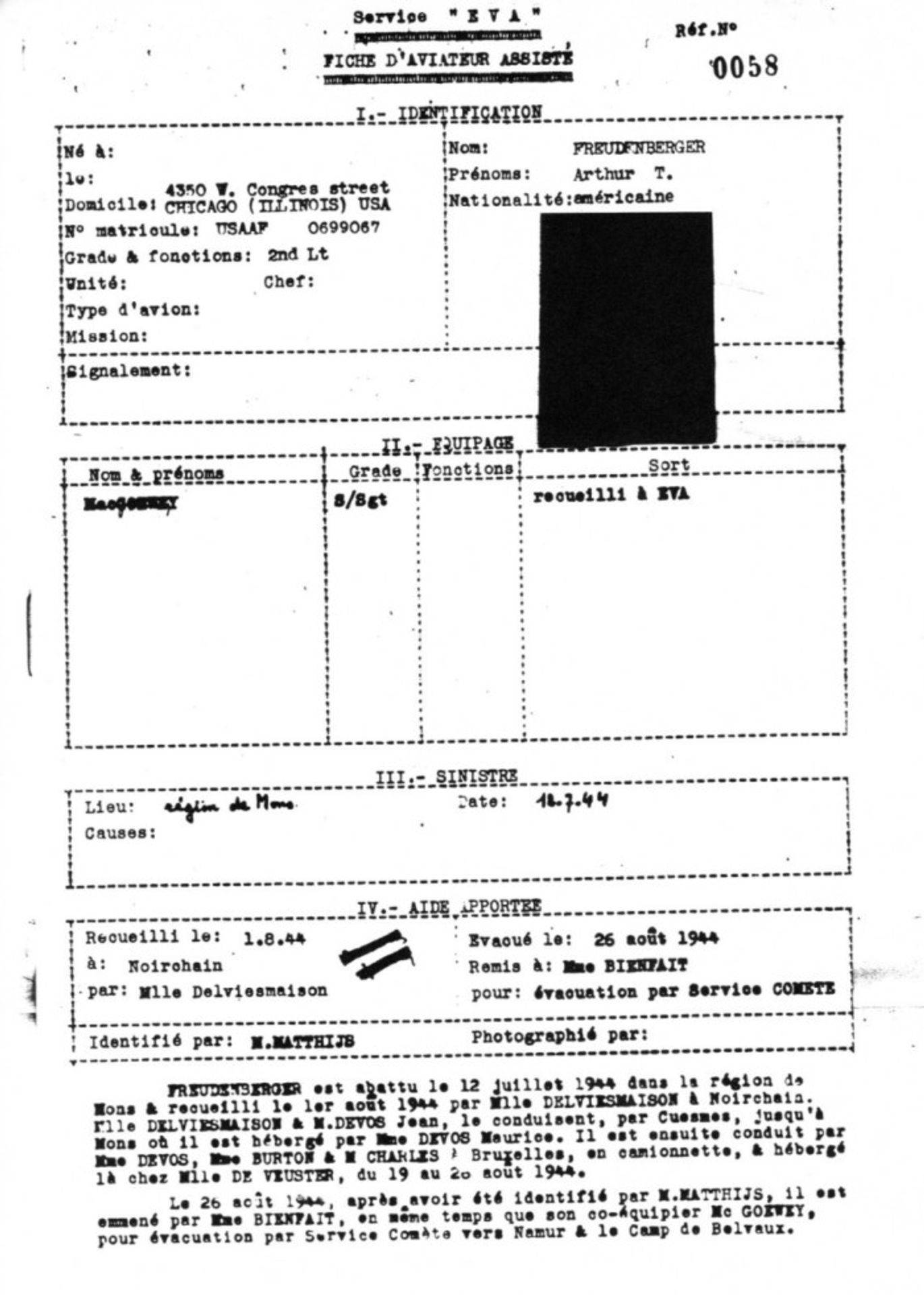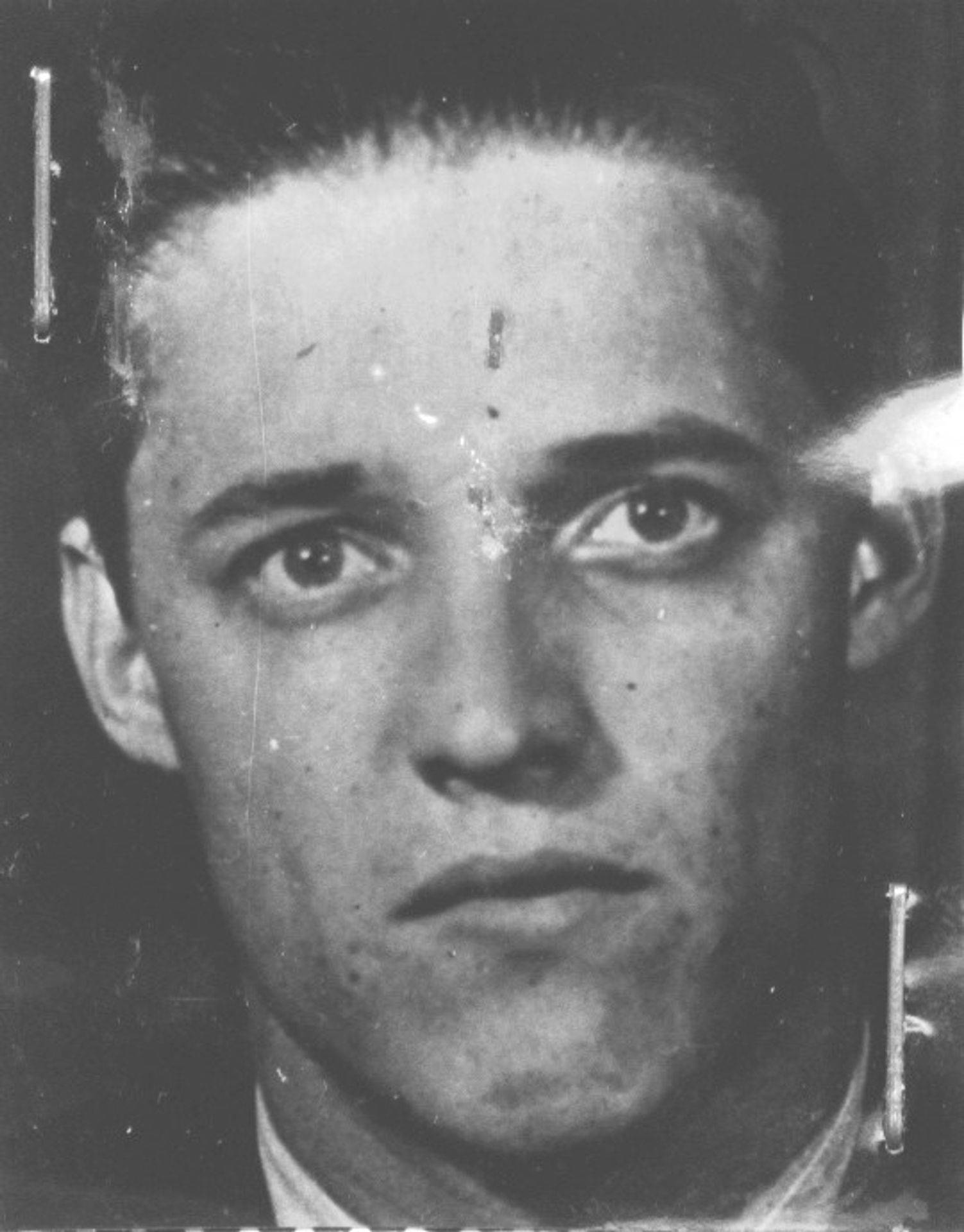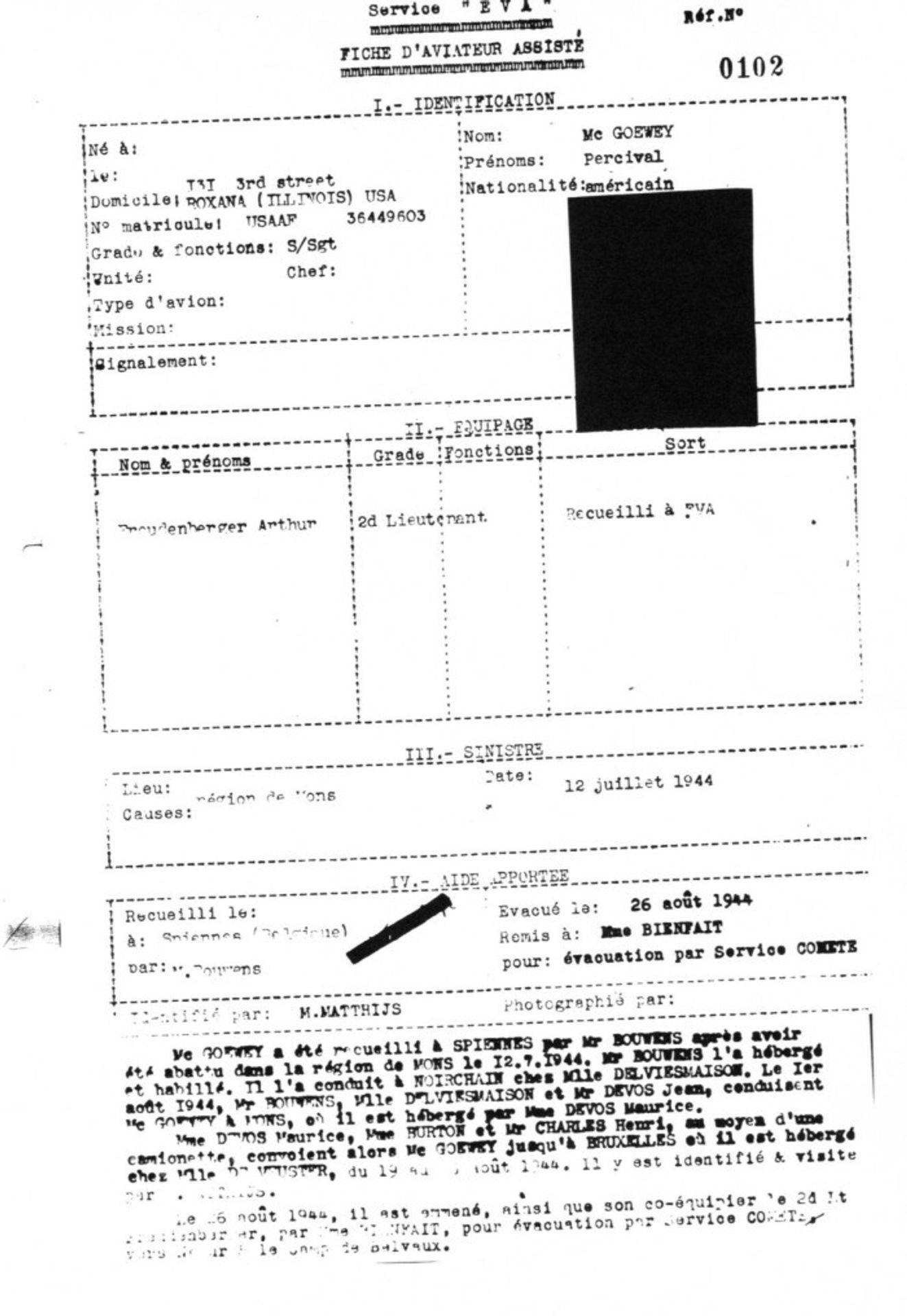Quirk Crew – Assigned 755th Squadron – May 1944

Sitting: Fred Gaine – N, Charles Quirk – P, George Campbell – CP, Dave Jelinek – B
Shot down over Belgium July 12, 1944 – MACR 6930
| Rank | Name | Serial # | Pos | Date | Status | Comments |
|---|---|---|---|---|---|---|
| 1Lt | Charles W Quirk | 0812653 | Pilot | 12-Jul-44 | POW | Stalag Luft III |
| 2Lt | George A Campbell, Jr | 0761801 | Co-pilot | 12-Jul-44 | POW | Stalag Luft III |
| Capt | Charles F Gaine | 0703074 | Navigator | Mar-45 | CT | Trsf to 70RD for return to ZI |
| 1Lt | David C Jelinek | 0698019 | Bombardier | Jan-45 | CT | Awards - Distinguished Flying Cross |
| T/Sgt | Thomas J McQueen | 14178151 | Flight Engineer | 12-Jul-44 | POW | Stalag Luft IV |
| T/Sgt | Gerald K Miller | 37657645 | Radio Operator | 12-Jul-44 | EVD | E&E Report 1695 |
| S/Sgt | Charles C Hillis III | 39043686 | Top Turret Gunner | 12-Jul-44 | EVD | E&E Report 1862 |
| S/Sgt | Donald H Swanson | 37552256 | Ball Turret Gunner | 12-Jul-44 | EVD | E&E Report 1861 |
| S/Sgt | Percival M Goewey | 36449603 | Waist Gunner | 12-Jul-44 | EVD | E&E Report 1902 |
| S/Sgt | Donald W Pierce | 31326085 | Tail Turret Gunner | 12-Jul-44 | POW | Stalag Luft IV |
The Quirk crew was assigned to the 755th Squadron about mid-May 1944. Their first mission was flown on D-Day with seasoned pilot 2Lt Larry Riesen and navigator 1Lt Sam Scorza (Crew 74). Dave Jelinek manned a waist gun that day and Fred Gaine and George Campbell flew with other crews. They flew the 458th’s second mission of the day, but due to 10/10’s cloud cover over the invasion coastal areas the squadron brought all of their bombs back to Horsham St. Faith.
Over the next month the crew flew 12 additional missions to several targets in France, Belgium, and three trips to Germany. On the June 21st mission to Berlin they were forced to abort due to a fuel leak. On July 11, 1944 the 458th’s target was the Marshalling Yards in Munich. Flying one of the original ships in the 755th Squadron 41-29342 Rough Riders, the crew was once again forced to abort due to a fuel leak in the right Tokyo tank. They jettisoned their bombs and returned to base for no sortie credit.
On July 12, 1944 the target was once again the Marshalling Yards in Munich. Quirk was initially assigned to fly in ship #342 again, but the aircraft was apparently not ready from the day before and they boarded ship number 42-100365 B on loan from the 752nd Squadron instead. The name of this ship is thought to have been Wolfgang, but it is not known for sure. Dave Jelinek, bombardier, had been grounded for several days with ear problems and he returned to duty on this date, but too late to accompany the crew to Munich. For unknown reasons Fred Gaine, navigator, was also absent from this mission. Filling in was 2Lt Arthur T. Freudenberger [E&E Report 1898], the bombardier on 2Lt Arthur F. Kenyon’s crew in the 755th. Freudenberger was listed as the navigator for this mission and would perform both navigation and bombardier duties.
Reports are not complete, but it is believed that Quirk and crew reached and bombed the target. Quirk was flying in the rear of the high right squadron and his element leader, 2Lt Alvie Livermore, saw Quirk’s aircraft fall back and lag behind the formation, “in no apparent trouble”. Arthur Freudenberger’s E&E Statement reported that the crew bailed out over Harveng, Belgium at 16:15 hours because they were “out of gas”, and 458th records state that, “ship #365 was last observed 10 minutes after bombs away apparently not in trouble flying with the 466th group. 466th reports on unidentified B-24, undamaged heading for Switzerland.” [This last could have been 2Lt Herbert C Hopkins crew from the 753rd Squadron who landed in Switzerland that day.] All of the crew bailed out and all chutes opened. German Kampf Flugzeuge USA [Battle Planes USA] Report KU2471 states that six men were observed jumping and that “probably eight men escaped”.
It is believed that all nine crewmen were assisted by the Belgian underground, although Quirk, McQueen and Pierce appear on German KU reports as being sent to Dulag Luft (the transit camp for allied airmen) it is not known exactly when they were captured. George Campbell spent a number of weeks with Belgian helpers before he was captured by the Germans. He and several other evadees (including a number of other 458th crew members) were rounded up when the “safe house” they were in was raided by the Gestapo. The escape line had been compromised by a man named Prosper De Zitter, who was tried for treason after the war and was executed by firing squad.
Freudenberger, Miller, and Goewey were liberated on September 11, 1944 by American forces in the Ardennes. They were back in England within a week. Swanson & Hillis were also back in England by September 1944. Swanson’s journey is currently undocumented, but Hillis was on the “Ghost Train” in late August 1944. The Gestapo loaded a train in Brussels with prisoners bound for Germany–and almost certain death. It never arrived, and the saga of the so-called “Ghost Train” is one of the most incredible, inspiring stories of World War II.
The Belgian resistance simply refused to let the train and its cargo of resistance fighters, captured soldiers and political undesirables leave the country. Every time it departed Brussels, it encountered obstacles, from blown-up tracks to a sabotaged water supply to an engineer deliberately injuring himself so he couldn’t drive the train. Eventually over 1500 political prisoners and about 50 Allied airmen were released by the Germans in late August 1944 just before the Allies overran the area.
2Lt David C. Jelinek continued to fly with various crews, eventually becoming a part of 2Lt Searcy Glass’ crew in the 752nd Squadron. He was promoted to 1st Lieutenant in October 1944, completed his combat tour in January 1945 and was awarded the Distinguished Flying Cross (DFC).
2Lt Charles “Fred” Gaine was chosen to be a lead navigator and also flew with a number of different crews, possibly ending up on Capt Raymond T. Hemrich’s crew in the 755th Squadron. Gaine was eventually promoted to the rank of Captain and finished his combat tour in March 1945 with two DFC’s. Sadly he died of polio in late 1945 or 1946 while attending school in the Boston area.
T/Sgt Thomas “TJ” McQueen survived the forced march to Czechoslovakia in the late winter of 1945 when the Germans evacuated Stalag Luft IV ahead of the Russian advance. Upon his liberation, he was diagnosed with Tuberculosis and had to stay an additional year in a TB sanitarium. He eventually returned to his home in Birmingham, AL.
April 1944 – Topeka Army Air Field
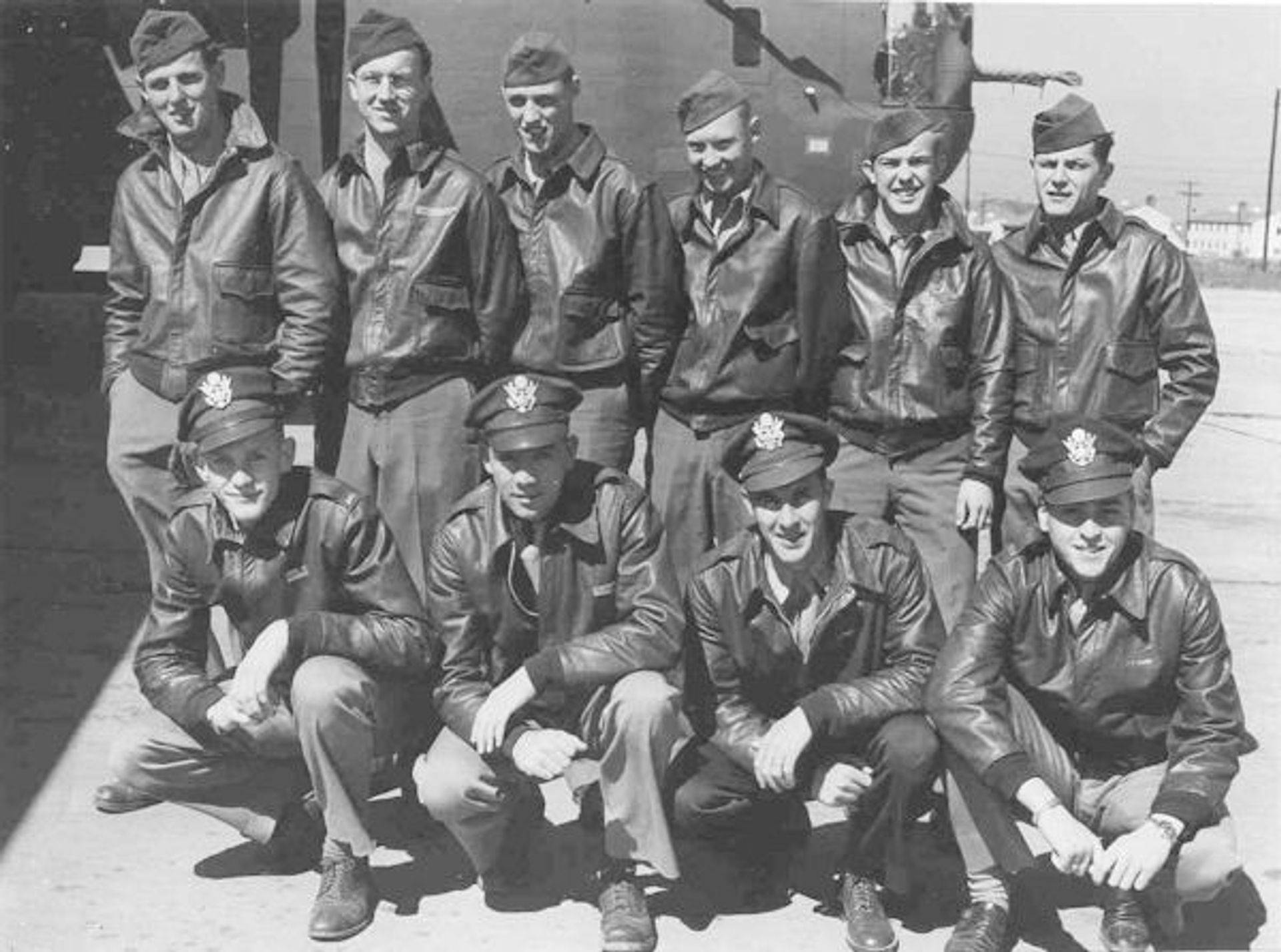
Missions
| Date | Target | 458th Msn | Pilot Msn | Serial | RCL | Sqdn | A/C Msn | A/C Name | Comments |
|---|---|---|---|---|---|---|---|---|---|
| 11-Jun-44 | BEAUVAIS | 63 | ABT | 41-29300 | Y | J3 | -- | LORELEI | #2 ENG, #4 TURBO |
| 12-Jun-44 | EVREUX/FAUVILLE | 64 | 1 | 41-29342 | S | J3 | 23 | ROUGH RIDERS | |
| 15-Jun-44 | GUYANCOURT | 66 | 2 | 42-95183 | U | J3 | 7 | BRINEY MARLIN | |
| 17-Jun-44 | TOURS | 68 | 3 | 42-50320 | W | J3 | 22 | UNKNOWN 018 | |
| 19-Jun-44 | REGNAUVILLE | 71 | 4 | 42-95008 | R | J3 | 14 | UNKNOWN 035 | MSN #1 |
| 20-Jun-44 | OSTERMOOR | 73 | 5 | 42-52441 | I | J3 | 34 | LAST CARD LOUIE | MSN #1 |
| 21-Jun-44 | BERLIN | 75 | ABT | 41-28735 | V | J3 | -- | UNKNOWN 005 | ABORT - GAS LEAK |
| 23-Jun-44 | 3 NO BALLS | 76 | 6 | 42-110184 | F | J3 | 7 | GWEN | TGT #8 BLANE-PIGNOT-FERNE |
| 24-Jun-44 | ST OMER | 78 | 7 | 41-29288 | L | J3 | 34 | BIG-TIME OPERATOR | |
| 28-Jun-44 | SAARBRUCKEN | 81 | 8 | 41-29342 | S | J3 | 26 | ROUGH RIDERS | |
| 02-Jul-44 | COUBRONNE | 83 | 9 | 42-52441 | I | J3 | 35 | LAST CARD LOUIE | |
| 05-Jul-44 | LE COULET, BEL | 84 | 10 | 42-95120 | M | J3 | 18 | HOOKEM COW / BETTY | |
| 08-Jul-44 | ANIZY, FRANCE | 87 | 11 | 41-29342 | S | J3 | 28 | ROUGH RIDERS | |
| 11-Jul-44 | MUNICH | 88 | ABT | 41-29342 | S | J3 | -- | ROUGH RIDERS | GAS LEAK TOKYO TANK |
| 12-Jul-44 | MUNICH | 89 | 12 | 42-100365 | B | 7V | 36 | WOLFGANG | SHOT DOWN |
B-24J-95 CO 42-100365 7V B Wolfgang
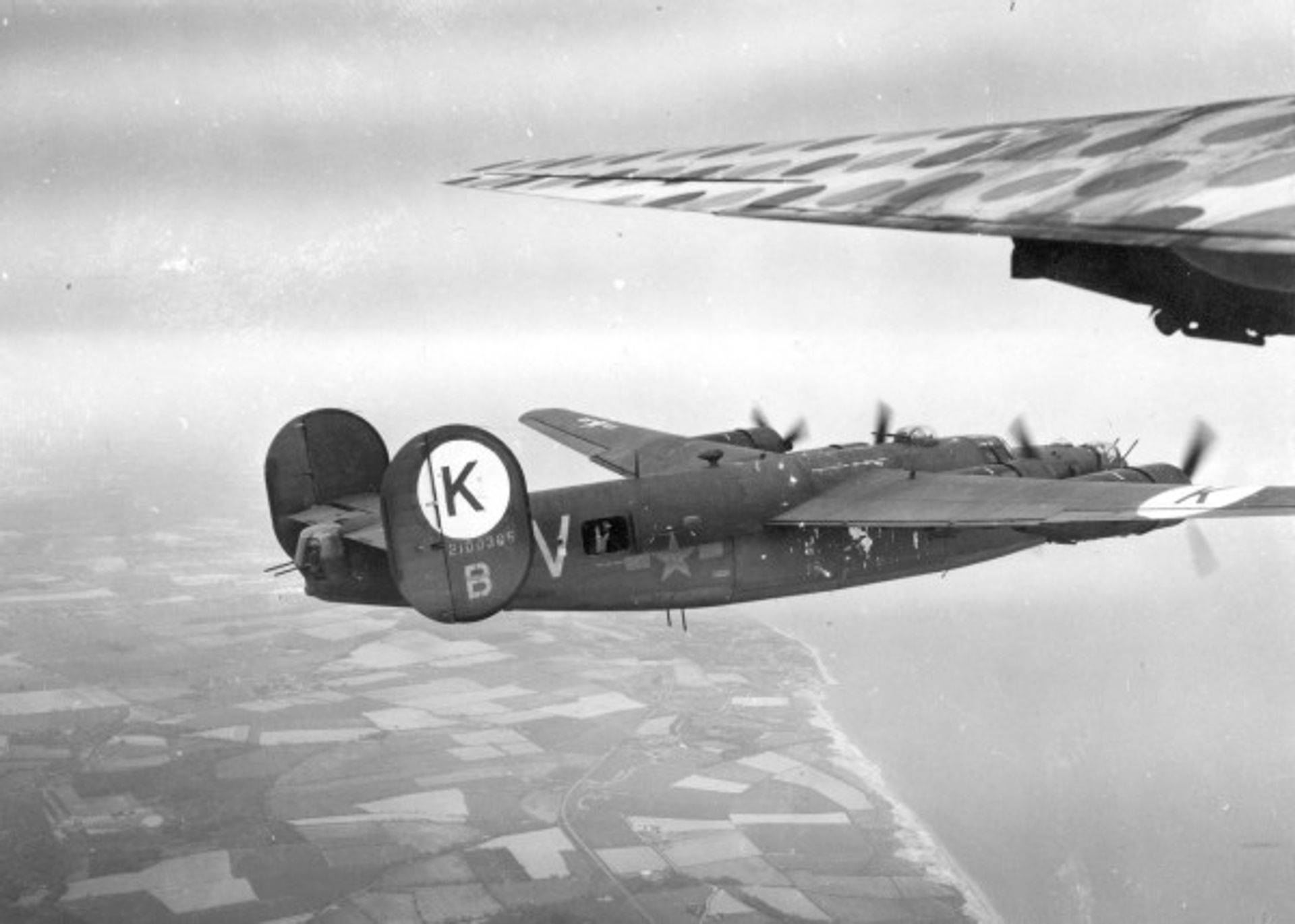
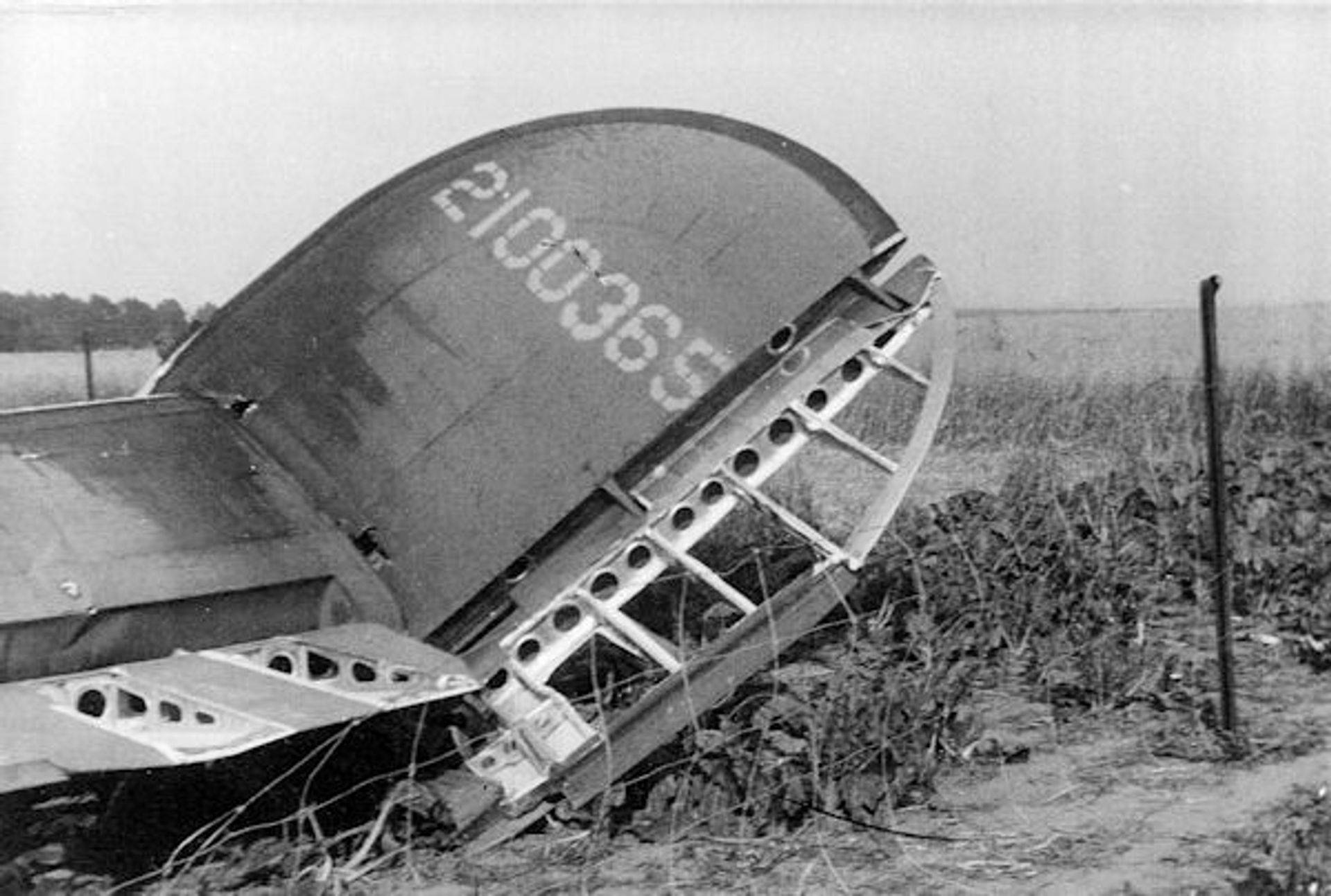
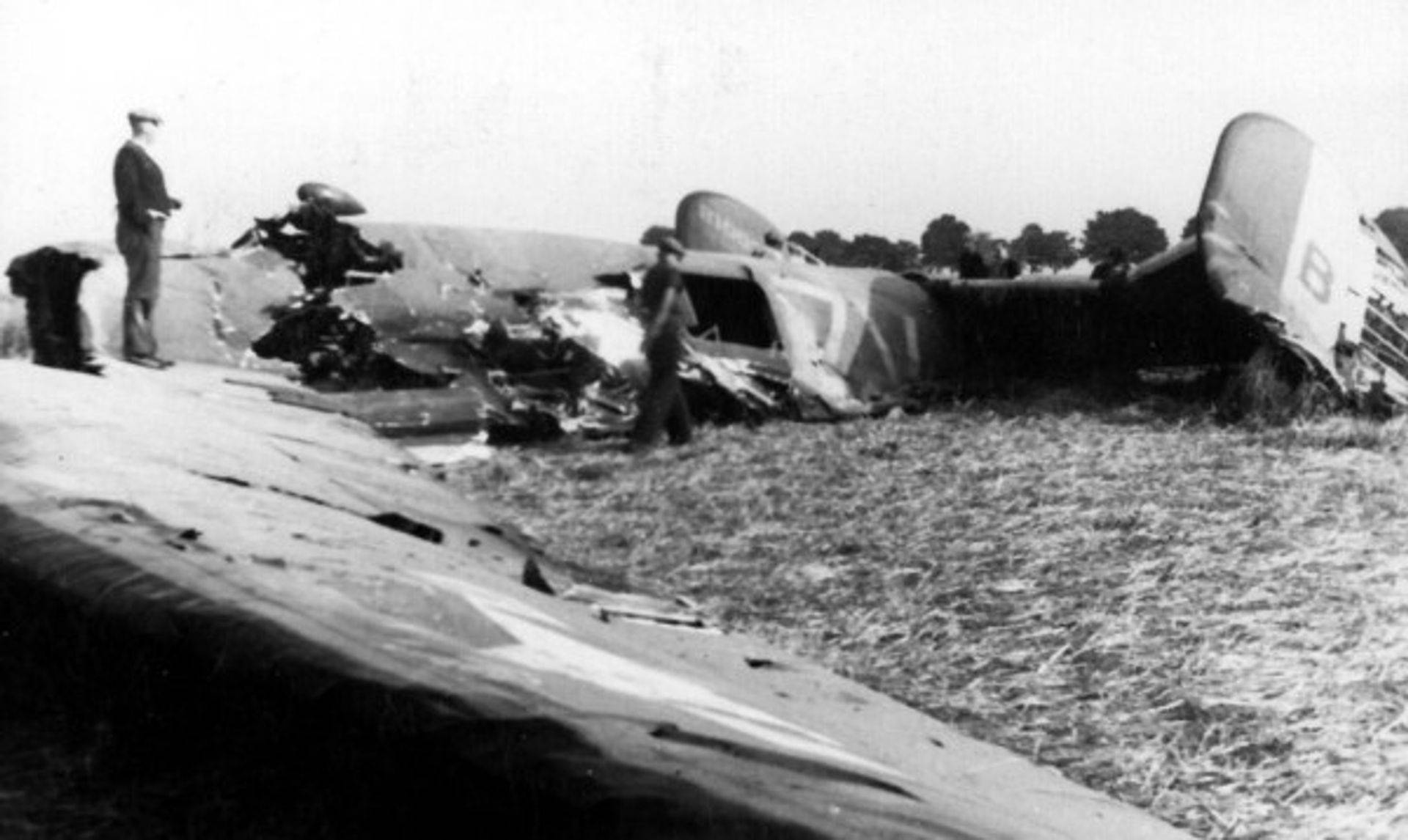
Evading American Airmen and their Belgian Hostesses
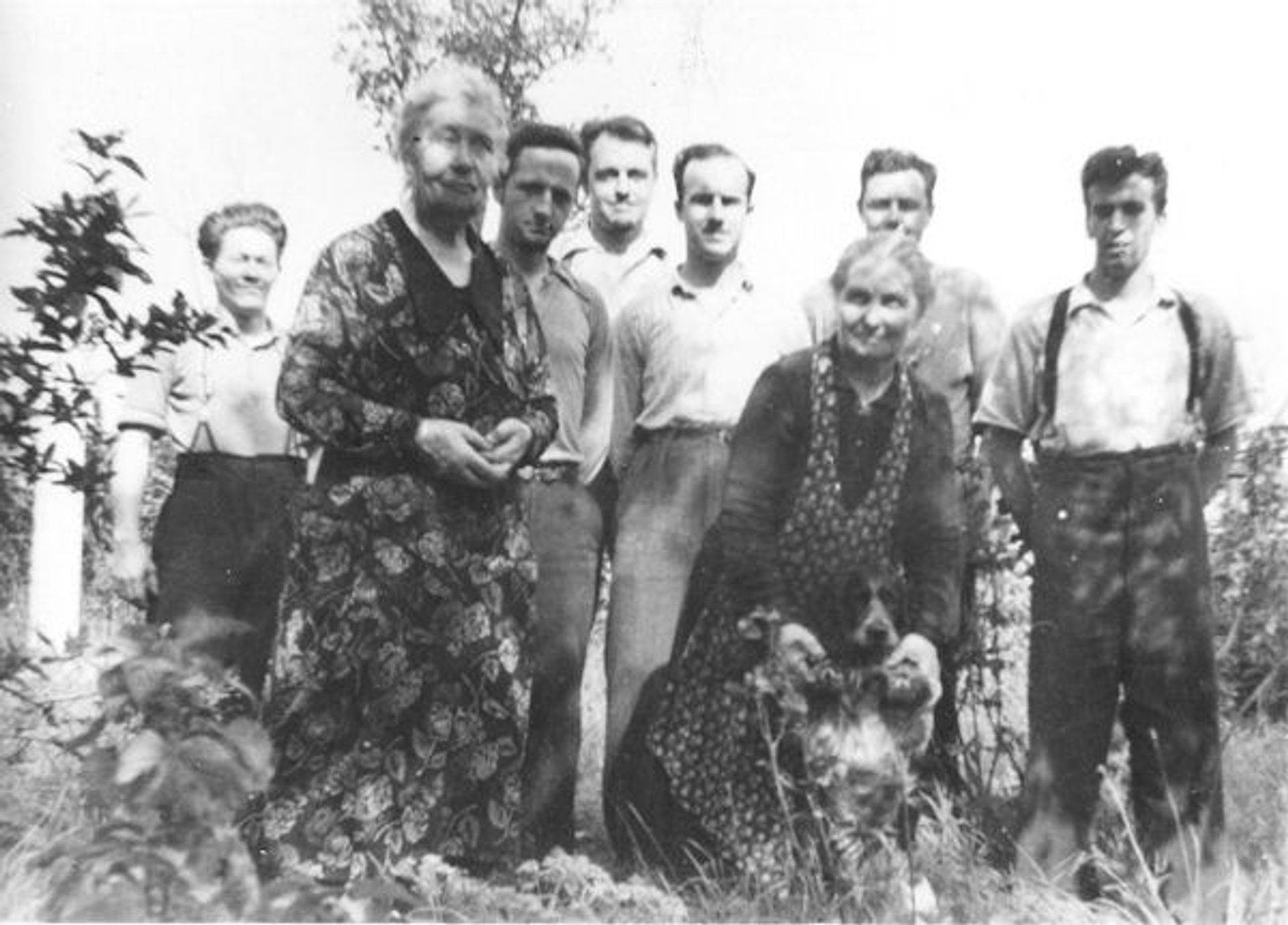
Back Row: Lester Smith – Chicago, Robert Walther – New Jersey, Don Dahlain – New Jersey, Gerald Miller – Des Moines, Waxey Gordon, Paul Herring – Ft. Meyers, FL
Front Row: Madame Anna Mislian, Madame Julia Biron with dog Flicka,
Photo: Gerald Miller
Paul Herring recalls his meeting with Gerry Miller in Blaregnies
“It must have been about the middle of July another downed American Airman joined us. He was Jerry Miller, a gunner from Des Moines, Iowa. He is only one of the men that was with me in Blaregnies that I have been able to keep up with. I attended an 8th Air Force reunion in Des Moines a few years ago and met some of Miller’s crew. Jerry and his wife Maureen have spent the winters in Sebring, Florida not far from Fort Myers, and we have been together several times.
“When Paris fell to the Allied Forces in August we felt the time for our liberation was near. The Germans were retreating Helter-Skelter and moving eastward in any manner they could; giving only sporadic resistance. On September 2, about 9 o’clock in the morning we heard and then saw an armored column coming down the road, the first Allies to enter Belgium were passing in front of the house. When we realized they were Americans we all ran out to greet them. It was a reconnaissance patrol of the 3rd Armored Division and the Sergeant in charge did not know what to think of six guys running out of a house claiming they were American airmen. He called one of the Company officers who came up and began to ask us questions to make sure we were who we were claiming to be. He asked Miller questions about Des Moines, where did he go to school, Miller told him the High School. The officer asked Miller where he went to Elementary School. The school he had attended was named for the officer’s grandfather. The officer said we were O.K. but we could not stay because we had exposed ourselves and the safety of the people who had helped us would be endangered and we must go with them. So after five months I gave Madame Biron and Madame Mislian a hug, thanked them profusely and left.”
(Courtesy: Philippe Save)
Belgian Helpers
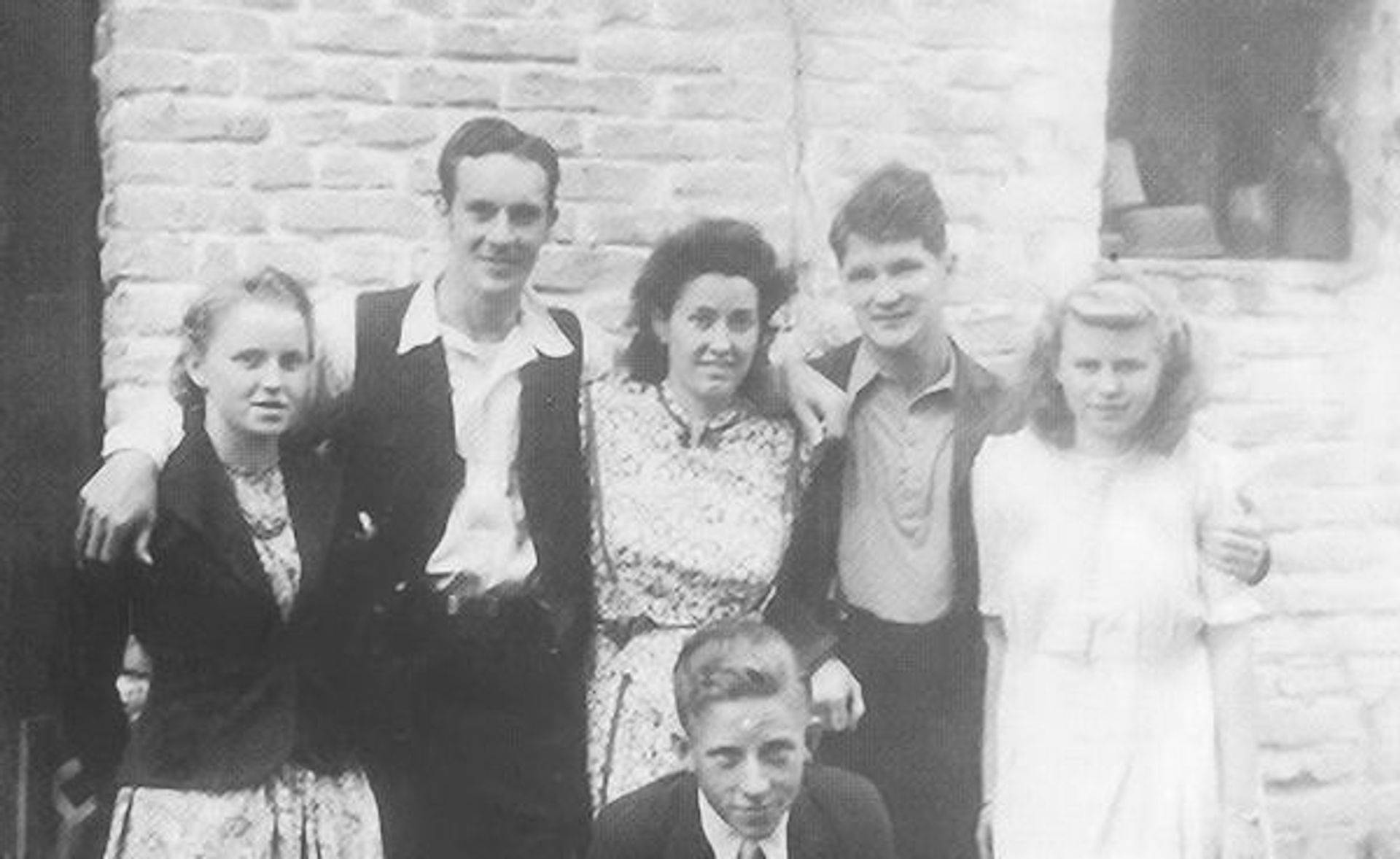
L-R: Louise Karolczak, George Campbell, Irma Caldow, Tommy Dowbiggin (RAF pilot), Louise Dubois, Jose Karolczak (center).
(Photo: Phototèque du cercle Les Dix Clochers,Quévy, Belgium via Philippe Save)
Irma Caldow: The Plane: a B-24
“Near the beginning of July 1944 I was at the place where the plane was turning back from the coast of Losveng. I saw two men jump. The apparatus was brought down by the Germans. One of the pilots fell to the ground and immediately cut the cords and shoved himself and everything into a hole. The other pilot quickly hid himself in an apple orchard. This orchard was the property of a gentleman from MOTTE (a baron). The baron thought that he might be hidden so well that the German dogs couldn’t even find him.”
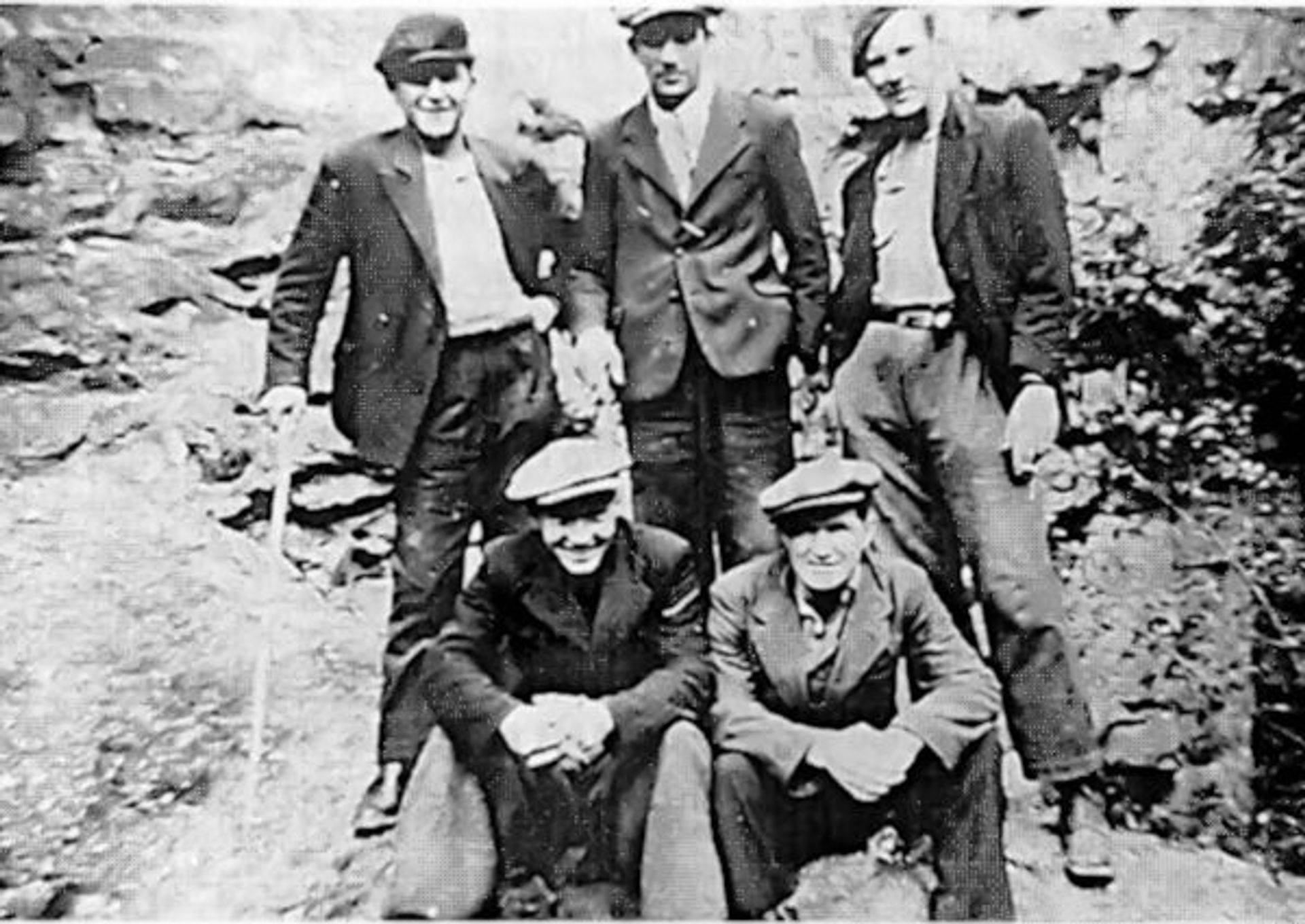
Quirk evaders at the quarry. Picture taken by Irma Caldow’s brother in the village of Givry
(Photo: Gerald Miller – Information: Philippe Save)
Point of meeting again
George Campbell, co-pilot of the B-24 [went] with Irma Caldow who led him to a quarry where he joined the other members of his crew.
Irma remembers: “I knew the parachute was where I would find the pilot. He appeared walking out with many apples. He had so many apples in his pockets and in his uniform that it made the uniform look too small. He was even carrying his boots so that he could carry apples in them too.
The pilot had a bad headache and had to go to bed. He stayed there until 2 A.M. We stayed on the main road until we got to Givry. It was there that he gave me his silver wings. I left the aviator there and asked him if everything was okay. He answered. “Affirmative!” and I went back to get the pilot. The doctor came to care for George who had to rest for three days because his body hurt everywhere.”
George Campbell spent several days hidden in the village of Givry. It was here that he was able to rejoin the others [of his crew].
2Lt Arthur T. Freudenberger – Navigator
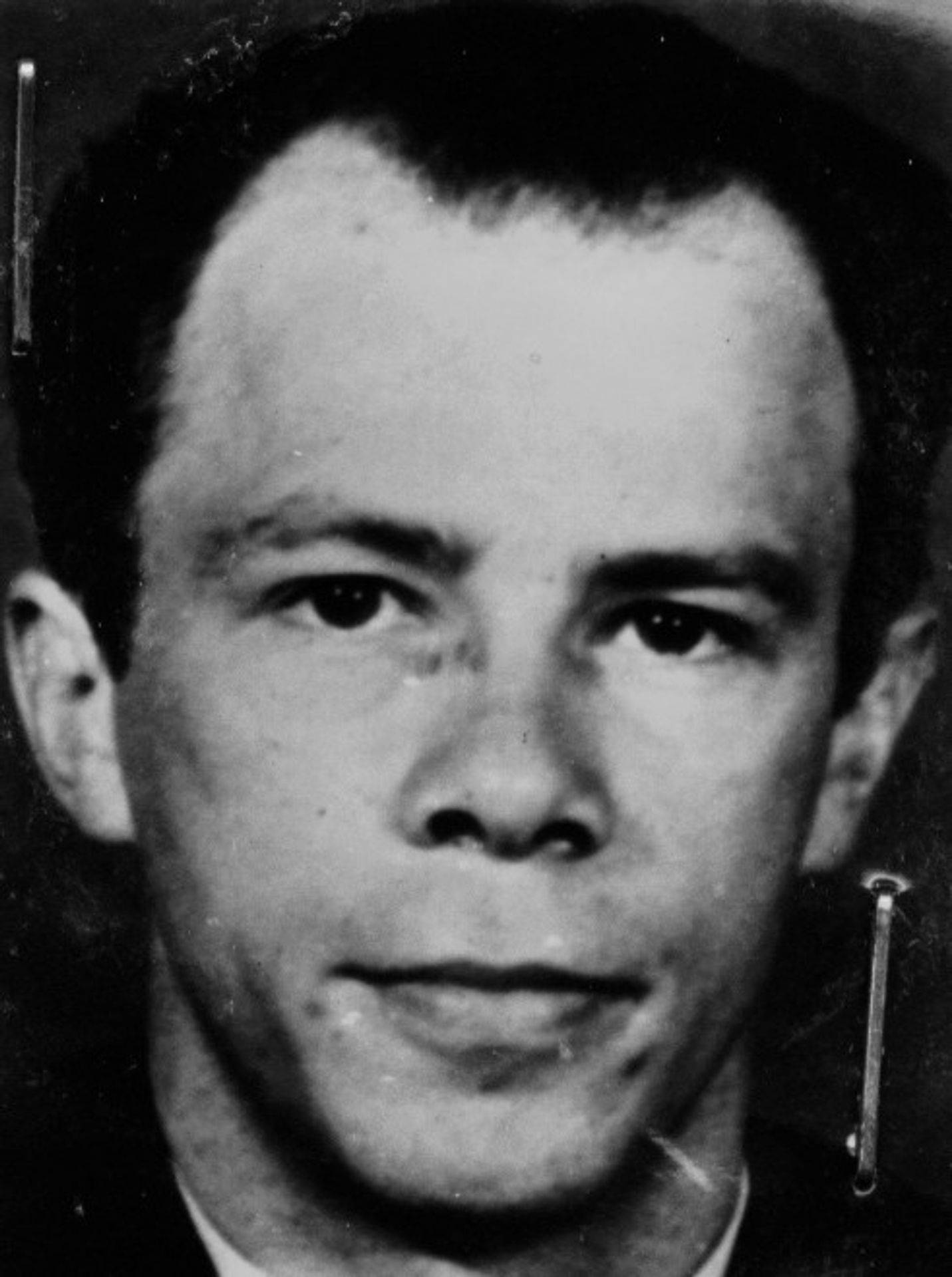
Letter from Arthur Freudenberger describing his stay in Belgium
Thank you very much for your letter. Please be advised that anything I can do to help the people who befriended me during my stay in Belgium, I will gladly do so. Due to the fact that many of my helpers assumed fictitious names for their own protection, it may be difficult to trace some of them down; however I do have the real names of some of the persons.
Following is a resume of my experiences in Belgium as near as I can give same.
I, along with the rest of my crew, parachuted from a disabled B-24 July 12, 1944. I landed in a Canal near the village of Frameries, Belgium. The first person I came into contact with was a messenger of the Belgian underground named Mlle Rivart Fernande who went by the name of “Nadia”. Her age was approximately 18 years. I received a letter from her some time ago and her return address at that time was Rue de la Clinique, number 52, Anderlecht, Brussels Belgium. Her father’s home was in Frameries, and she worked in that locality. She was very helpful and we were in constant tough with her for five or six weeks, during which time she supplied us with food, cigarettes, and information. When I speak of us, I mean my nose gunner, Percy Goway, who was with me most of the time.
Nadia took her orders from a man named Eddie (a fictitious name). I am enclosing his picture which I brought out with me. I understand he was a wanted man and naturally never did know his true name. Eddie also was a very big help to us and was with us most of the time while we were in Frameries. He also arranged our passage, through the underground to Mons and to Brussels. His friend “Mick” (a fictitious name) and his wife helped us and we stayed in their home several days.
We then moved to a farm in Frameries… the owner’s name being Gaston. Either Eddie or Nadia can give their correct name and address. We stayed there approximately 10 days. Then there was a fellow who went by the name of Georgie (a fictitious name). We stayed at his home for a few days. Eddie can also tell his name and address. Upon leaving the farm, we were sheltered and fed by a family in Frameries. I am quite sure their name was Lhost Gaston living at Rue Ferrer 268 Frameries. These people were exceptionally nice and we stayed there about 2 weeks. We then went to Mons, Belgium via bicycle and stayed overnight with M. Devos, 6 Ave de Guerites, Mons. Our fictitious identification cards were made out by this man and he arranged passage to Brussels.
In Brussels we stayed at the home of Claire DeVeuster, 35 Rue de Marche au Charlon, Brussels. At this place, we were befriended by a Margaret Gilbert 18 Rue Botanique, Brussels. Mlle De Veuster can give you the names of the men who arranged our trip from Brussels through Namur and into the Ardennes Woods. The trip was made by bicycle. We were liberated 11 September 1944 after staying about two weeks in the Ardennes. The above people were the principle characters who aided us and all were very helpful.
I would appreciate it very much if you will return the enclosed snapshot when you are finished with same; and if you contact any of these people, wish you would ask them to contact me. I sincerely hope this information will be of some help to you as well as my good friends.
If I can be of any further service, please call upon me.
(Courtesy: Ron Freudenberger)
FREUDENBERGER Recovered 01/08/44 in Noirchain by Miss Delviesmaison.
Freudenberger was shot down on 12 July 1944 in the area of Mons and recovered on the 1st of August 1944 by Miss Delviesmaison.in Noirchain. Miss Delviesmaison and Mr Jean Devos guided hin to Mons via Cuesmes, where he was sheltered by Mrs Maurice Devos. Following this he was guided to Brussels in a truck by Mrs Devos, Mrs Burton and Mr Charles and sheltered at the home of Miss De Veuster from 9 August till 26th of August. On the 26th of August 1944, after having been identified by Mr Matthys (Matthijs in Flemish), he was handed over, together with his crewmate, McGoewey [sic] to the Comete service for evacuation via Namur to the camp at Belvaux.
Information & Photo: Michael LeBlanc
Sgt Percival M. Goewey – Nose Turret Gunner
McGOEWEY [sic] McGoewey was recovered in Spiennes by Mr Bouwens after having been shot down in the area of Mons on 12/07/44. Mr Bouwens sheltered and clothed him. He guided him to Noirchain to the home of Miss Deviesmaison. On the 1st of August, Mr Bouwens, Miss Delvisemaison and Mr Jean Devo guided McGoewey to Mons where he was sheltered by Maurice Devos. Mrs Maurice Devos, Mrs Burton and Mr Henri Charles has use of a truck, droved McGoewey to Brussels where he was sheltered at the home of Miss (Claire) De Veuster from the 19th of August to the 26th of August. He was indetified and visisted by Mr (Gaston) Matthys. On the 26th of August, he was taken, together with his crewmate, 2nd Lt Freudenberger, by Miis Bienfait, for evacuation by the Comete service towards the Belvaux camp (part of the Mission Marathom plan).
Information & Photo: Michael LeBlanc
Belgium exhibit – showing where the crew landed
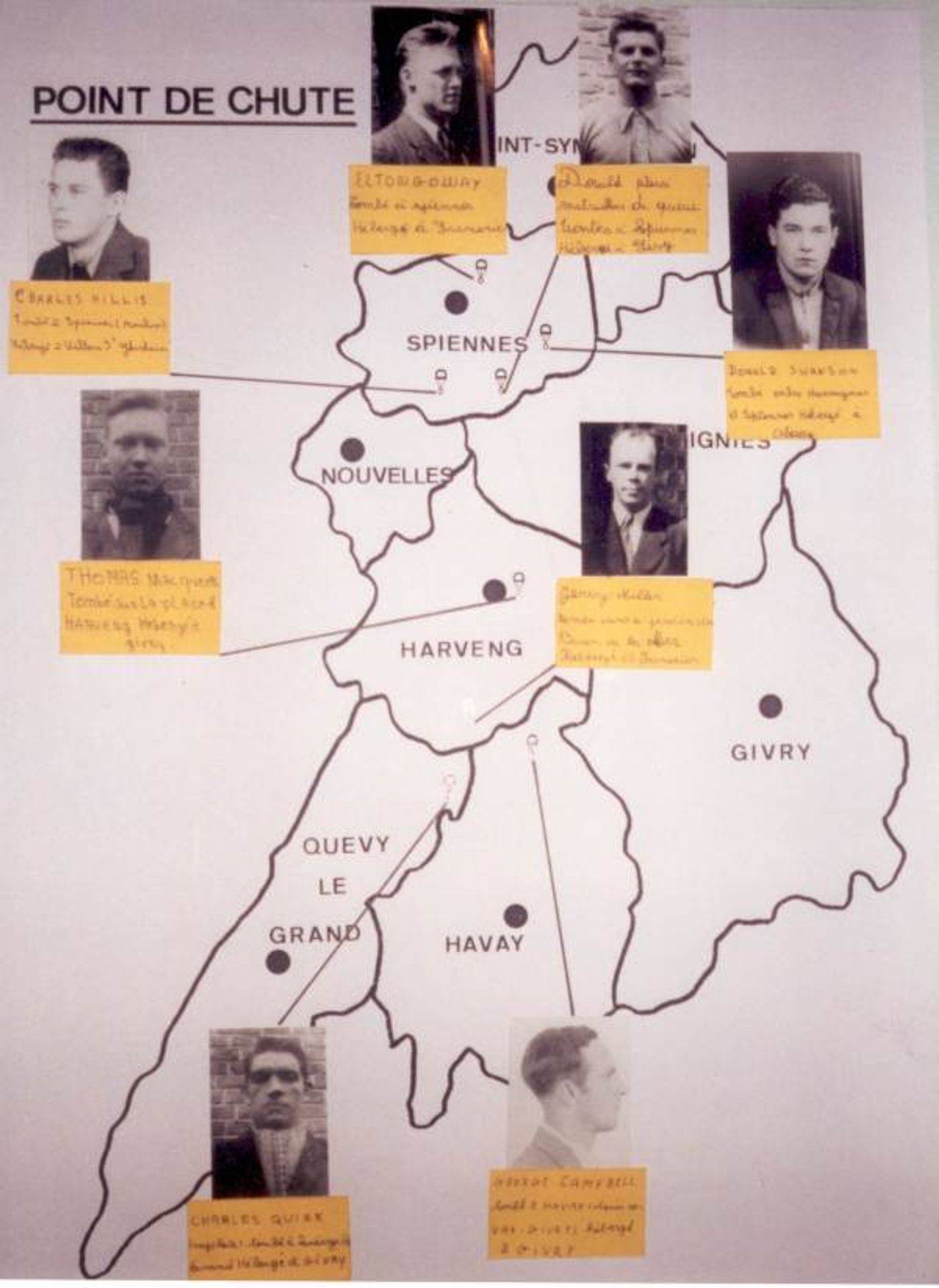
Clockwise from top: Goewey, Pierce, Swanson, Freudenberger (mistakenly identified as Miller), Campbell, Quirk, McQueen, Hillis
Courtesy: Gerald Miller

